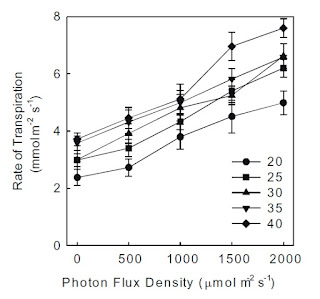Notes on Water Use Efficiency
Water use efficiency of plants, also called transpiration efficiency (TE) refers to the amount of water transpired per unit biomass produced by the plant. It is easy to measure for a particular situation if plants are grown in pots and direct evaporation from the pot minimized, just measuring pot weight, assuming that changes are mainly due to transpiration ( a good assumption) and harvesting biomass. Then you will have Biomass/water transpired or TE. The TE is highly influenced by environmental variables but particularly by vapor pressure deficit in the atmosphere (VPD) and by CO2 concentration. To compare results with other determinations of TE you can normalize your values by VPD and CO2 concentration in the atmosphere.
As you can see from the previous paragraph you do not need to maintain a constant soil water content to measure TE since what you are really interested in is water loss by transpiration. Of course you can measure TE under well irrigated conditions and under drought conditions.
If you have a crop under different watering regime you can also estimate TE by plotting biomass or yield in the Y axis and ET (evapotranspiration) in the X axis. A linear plot is produced whose slope is the TE and the intercept in the X axis the soil evaporation. It is worth keeping in mind that TE is similar for species of a given carboxilation group (C3 or C4) even though differences within species have been reported.
How do you estimate the water use efficiency of plants?. Available from: https://www.researchgate.net/post/How_do_you_estimate_the_water_use_efficiency_of_plants [accessed Jul 24, 2017].
Water use efficiency of plants, also called transpiration efficiency (TE) refers to the amount of water transpired per unit biomass produced by the plant. It is easy to measure for a particular situation if plants are grown in pots and direct evaporation from the pot minimized, just measuring pot weight, assuming that changes are mainly due to transpiration ( a good assumption) and harvesting biomass. Then you will have Biomass/water transpired or TE. The TE is highly influenced by environmental variables but particularly by vapor pressure deficit in the atmosphere (VPD) and by CO2 concentration. To compare results with other determinations of TE you can normalize your values by VPD and CO2 concentration in the atmosphere.
As you can see from the previous paragraph you do not need to maintain a constant soil water content to measure TE since what you are really interested in is water loss by transpiration. Of course you can measure TE under well irrigated conditions and under drought conditions.
If you have a crop under different watering regime you can also estimate TE by plotting biomass or yield in the Y axis and ET (evapotranspiration) in the X axis. A linear plot is produced whose slope is the TE and the intercept in the X axis the soil evaporation. It is worth keeping in mind that TE is similar for species of a given carboxilation group (C3 or C4) even though differences within species have been reported.
How do you estimate the water use efficiency of plants?. Available from: https://www.researchgate.net/post/How_do_you_estimate_the_water_use_efficiency_of_plants [accessed Jul 24, 2017].

Comments
Post a Comment